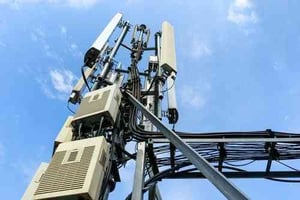6 Ways Small Cell Infrastructure Is Impacting the Industry

Several years ago, the buzz began about the incoming mass deployment of small cell attachments. Annual deployment continues to expand.
To fully understand what this growth means for your company, review this list of 6 insights about small cell proliferation.
1. Small cell greatly impacts joint use asset management professionals.
In 2017, roughly 13,000 small cell attachments were deployed across the United States. By 2019, annual deployment was 46,000 and the number of active small cell sites neared 400k, according to the wireless trade association CTIA.
The United States has more wireless devices than people, and one in five American households relies on a smartphone as the sole source of home Internet access.
Such an increase in attachments will certainly impact the joint use community. Asset owners must prepare for a massive increase in both inquiries and permitting requests; attachers must prepare for high-volume, fast-paced deployment rates.
2. One Touch Make Ready fuels rapid small cell deployment.
In 2018, the FCC unanimously enacted a policy intended to speed the deployment of small cell attachments throughout the country. The agency’s One Touch Make Ready order allows the attaching company itself to remove all wires and equipment previously on the pole, so they can prepare the pole for a new attachment.
Before that, the provider had to wait for each company that was already using the pole to remove its equipment. That process could take weeks or months. They first had to verify the equipment could be moved, contact the previous attacher for removal protocol, then wait on contractors to remove the pieces.
Sometimes equipment removal was performed one-by-one or required multiple trips to the pole’s location. Add contracts, billing, and other paperwork to the mix and the result is typically a 30, 60, or 90-day turnaround time for deployment. Opponents argued that the policy favored new providers over established ones and risks damage to the older equipment.
The rule does not apply to some types of attachments, such as those with potential to cause safety risks. In addition, it only applied in the 30 states where pole attachments are regulated by the FCC. While the policy provides state and local governments leeway to regulate deployments, it forbids moratoria that block or delay installation.
According to former FCC Commissioner Jonathan Adelstein, next-generation technology will require more deployment of facilities. With the influx of small cell and DAS deployment, “all communities reap the benefits of wireless broadband.”
3. The best support for 5G is small cell.
Communications providers want to know the best way to ensure networks can handle 5G high-speed wireless service and the wave of integrated technologies that continue to roll out over the next few years.
The next generation of wireless service delivers lightning-fast speeds and more reliable connections. Currently, different providers are offering various levels of 5G service — high-band, mid-band, and low-band — but all are looking to greatly expand 5G offerings moving forward. Small cell is an essential part of 5G networks, especially for high-band service. According to CTIA, U.S. wireless industry investment in 2019 was $29.1 billion, representing a four-year high and 18 percent of world investment.
4. Small cell encourages smart cities.
Small cell is the key to tapping into the full potential of smart cities, in which sensors will perform a multitude of functions that increase efficiency, save money, and improve public safety. Small cell boosts wireless signals so that multiple devices, appliances, and machinery can connect. A few uses include:
- Smart lighting: The same way sensory lights in our homes or offices operate, sensors in smart cities will automatically dim public lights on empty streets and turn them back on if a person or vehicle appears.
- Improved traffic flow: Traffic lights will be able to respond to actual traffic with sensors, which should reduce congestion.
- Parking assistance: Sensors will be able to communicate parking space availability through an app to drivers or passengers in real-time, eliminating the need to keep circling the block looking for an empty space.
- Better public safety: Gunshot detectors will lead to quicker, more informed police response (possibly even identifying the type of firearm used). Severe weather warnings will improve, and sensors will communicate which streets to avoid during flash floods.
- Smart power: Power grids will have more information about power usage and will be able to manage the system more efficiently, saving energy. Information about power outages will be detected and relayed immediately, helping responders get the lights back on sooner.
As beneficial as small cells are for powering smart cities, residents in those cities may grow weary. Cities have, and will continue to, regulate the appearance of small cell attachments. Expect the attention from municipal governments to grow as deployment escalates. Residents may call to complain about attachments they find unsightly in their neighborhoods.
5. Demand for fiber is strong.
Other forms of backhaul will be employed depending on small cell location, but it’s clear that wireless providers feel comfortable with fiber’s capacity and reliability.
Both Verizon and AT&T have said they expect to increase spending on fiber. A report projects that the fiber optic market will expand at a compound annual growth rate of 10.5 percent through 2026. The small cell boom is just one factor, but upgrades to boost fiber density are also a significant part of small cell preparations.
6. Small cell creates new jobs.
Small cell attachments are not going to install themselves, and simply moving existing personnel from macro to small cell is unlikely to meet the increased demands for skilled labor.
Embracing Change
The joint use community is ever-changing. From the One Touch Make Ready policy to 5G, small cell deployment is on everyone’s mind. Utility pole and conduit infrastructure asset owners are seeking solutions and taking preventative measures to ensure their data is accurate. They are also looking for the best way to streamline communication between attaching companies and other asset owners.
For providers to better serve their respective communities, the best tools available to handle the complexity of joint use business are required.
New technology platforms can help owners and attachers build better communities by maintaining better infrastructure. Asset management platforms, like Alden One, will keep providers sane and organized in the face of change.
Download our guide today to learn how to meet the challenges associated with small cell technology. For questions about our products or services, book a meeting here.
